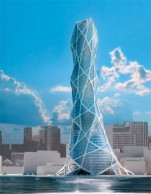Intelligent System

One of the architectural research tendencies, which have been issued relatively recently, but already deeply seated into everyday life, became Bionic that translated from Greek means “living.” Today, there are allocated three categories: biological, which studies the processes in organic systems; theoretical, engaged in the creation of mathematical (computer) models of these processes; and technological – responsible for the use of bionic models created for the realization in engineering or machinery. And right there, at the junction of the theoretical and technical fields is rooted architectural trend of Bionic. It studies the course of the formation and structure of living tissues, analyzing the structural systems of living organisms in terms of economy of material, energy and reliability, aiming at the ultimate goal in the synthesis of nature and modern technologies.
LAVA (Laboratory for Visionary Architecture) developed a project of the Bionic Tower, which embodies today the features of tomorrow’s architecture. The project looks ahead to capture future design criteria and create a high performance tower ‘now’. While breaking new grounds in computer science, nanotechnology, biotechnology and robotics, the Bionic Tower meets the challenges of modern society. Architecture of the future is not about the shape but about the intelligence of the system.
The tower proposes a naturally occurring system of structural organization that generates a building embodying efficiencies found within natural structures and architecture. Just as nature organically regenerates, so the building proposes a natural system of organic restructuring and reorganization. There is a unity in the structure, space and architectural expression, similar to cathedrals, and any natural system.
Learning from nature and advanced computing technologies enabled LAVA to conceive structures of incredible lightness, efficiency and elegance. The intelligence of the smallest unit results in the intelligence of the overall system.
By parametric modelling of the ‘behavioural logic’ the system has been constantly optimized throughout the design process to create a ‘whole’ that is greater than the sum of its parts. Instead of an array of individual elements the building behaves like an organism or ecosystem. Just as nature envisions organic regeneration, so the design proposes a natural system of organic structure and organization.
The Tower Design moves beyond the superseded modernist concept of extruded footprint and applied curtain wall to create a fully integrated intelligent façade that harvests its surrounding environment to create maximum energy efficiency and user comfort.
No building skin today approaches the performance of the biological world. The traditional curtain wall is passive, lacking the power to adjust to the fluctuating external environment. It should be able to intervene actively in the buildings struggle to maintain its internal stability. The building acts as a system, with a skin that controls air pressure, temperature, humidity, air pollution and solar radiation.
New materials and technologies enable an adaptability, responsiveness, environmental awareness and strength not seen in conventional architectural design. Architecture has to perform as an ecosystem within the organic tissue of the city.
Full content of this issue you can read here
The full version of the article can be read in our printed issue, also you can subscribe to the web-version of the magazine
 Materials provided by LAVA
Materials provided by LAVA


